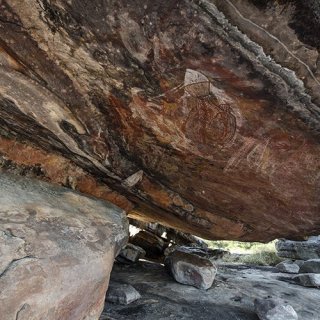Rock art
Kakadu’s rock art is of enormous international significance.
The park has one of the world’s greatest concentrations of rock art sites. Some paintings are up to 20,000 years old, which makes the artwork one of the longest historical records of any group of people on Earth.
The paintings provide a fascinating record of Aboriginal life over thousands of years, and show the close personal relationship Bininj/Mungguy share with their land and spiritual heritage.
Our main rock art galleries are at Ubirr and Burrungkuy (Nourlangie). Look for naturalistic paintings of animals, traditional x-ray art, and paintings of early contact with European people.
Culture
The local Aboriginal word for rock art is ‘kunbim’.
For Bininj/Mungguy, art is an expression of cultural identity and connection to country. The act of painting is generally more important than the painting itself, so older paintings are often covered by younger ones.
Bininj/Mungguy continue to tell their stories through painting, which is now mostly done on bark, paper and canvas.
Types of rock art
Rock art is still very relevant to local Aboriginal people. It shows objects they still use, animals they still hunt and activities they still do.
The rock art in Kakadu was painted for a number of reasons.
Some sites and paintings could only be painted by people with the right knowledge. For example, sorcery paintings could only be painted by the holder of magic knowledge. Other paintings, particularly at sites depicting the stories of creation ancestors, were often re-painted.
Paints
To make the paint, Bininj/Mungguy ancestors crushed pigments on a stone palette and mixed them with water to make a paste. They made brushes from human hair, reeds, feathers and chewed sticks. Sometimes they would use their mouths to blow wet pigments around objects to create a stencil. You can see hand stencils like this at Ubirr and Nanguluwurr.
Of all the paints, haematite (a reddish iron oxide) lasts the longest. That’s why the majority of old paintings that you see today are completely red.
Discover rock art at Kakadu
Take the first step
A journey of 1000 miles begins with a single click.
Enter your email to get free trip planning advice from Kakadu rangers.







